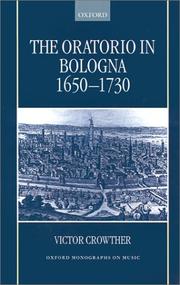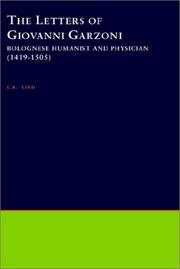| Listing 1 - 10 of 24 | << page >> |
Sort by
|

ISBN: 0198166354 Year: 2001 Volume: *31 Publisher: Oxford ; New York Oxford University Press
Abstract | Keywords | Export | Availability | Bookmark
 Loading...
Loading...Choose an application
- Reference Manager
- EndNote
- RefWorks (Direct export to RefWorks)
Oratorio --- Oratorios --- Church music --- Sacred dramatic music --- History and criticism --- Bologna (Italy) --- Bononia (Italy) --- Bologne (Italy) --- Bolonia (Italy) --- Bononia Pinguis (Italy) --- Felsina (Italy) --- Civilization --- Italy --- 17th century --- 18th century

ISBN: 0387949356 Year: 1998 Publisher: New York (N.Y.): Copernicus
Abstract | Keywords | Export | Availability | Bookmark
 Loading...
Loading...Choose an application
- Reference Manager
- EndNote
- RefWorks (Direct export to RefWorks)
Astronomy --- Calendar, Gregorian --- History --- Fiction. --- Gregory --- Bologna (Italy) --- Gregorian calendar --- Physical sciences --- Space sciences --- History&delete& --- Fiction --- Boncompagni, Ugo, --- Gregorio --- Gregorius --- Bononia (Italy) --- Bologne (Italy) --- Bolonia (Italy) --- Bononia Pinguis (Italy) --- Felsina (Italy) --- Grégoire
Book
ISBN: 9789004353480 9789004355644 Year: 2018 Publisher: Leiden Boston Brill
Abstract | Keywords | Export | Availability | Bookmark
 Loading...
Loading...Choose an application
- Reference Manager
- EndNote
- RefWorks (Direct export to RefWorks)
Long neglected by scholars, medieval and Renaissance Bologna is now recognized as a center of economic, political-constitutional, legal, and intellectual innovation, as the city that served as the cultural crossroads of Italy. The city's distinctive achievements and its transition from medieval commune to second largest city of the Renaissance Papal State is illuminated by essays that present the work of current historians, many made available in English for the first time, from the broadest possible perspective: from the material city with its porticoes, the conflicts that brought bloodshed and turmoil to its streets, the disputations of masters and students, and to the masterpieces of artists who laid the foundations for Baroque art.
History of Italy --- anno 500-1499 --- Bologna --- Renaissance --- Bologna (Italy) --- History --- Civilization. --- Revival of letters --- Civilization --- History, Modern --- Civilization, Medieval --- Civilization, Modern --- Humanism --- Middle Ages --- Bononia (Italy) --- Bologne (Italy) --- Bolonia (Italy) --- Bononia Pinguis (Italy) --- Felsina (Italy)
Book
ISBN: 9782869067059 2869067054 Year: 2019 Publisher: Tours Presses universitaires François Rabelais
Abstract | Keywords | Export | Availability | Bookmark
 Loading...
Loading...Choose an application
- Reference Manager
- EndNote
- RefWorks (Direct export to RefWorks)
"Connu pour son recueil d'emblèmes néo-latins, les Symbolicae Quaestiones (1555), illustré par Giulio Bonasone et qui connut un grand succès dans l'Europe de la Renaissance, Achille Bocchi (1488-1562) fut une figure majeure de la vie littéraire et culturelle à Bologne au XVIe siècle. Ce lecteur au Studio de la ville présidait une académie qui se réunissait dans son palais bolonais et accueillait un cercle important d'hommes de lettres, prélats et artistes. Le présent ouvrage, qui fait suite à notre édition commentée et traduite des emblèmes de Bocchi (PUFR/PUR, 2015), propose pour la première fois l'édition, la traduction, et l'annotation de trois textes inédits, accompagnées de vastes introductions, qui permettent de mieux comprendre l'activité de cet auteur et de son cercle, et, plus largement, de comprendre la circulation des idées et des pratiques littéraires au XVIe siècle. Ces trois opuscules complémentaires, qui couvrent une pucolique de Virgile à la Renaissance : réconcilier le plaisir et la vertu. ériode allant de 1515 à 1556, s'illustrent par leur variété générique et par l'importance des questions philosophiques, politiques et religieuses qui y sont soulevées. Tandis que le Démocrite ou la vanité propose une praelectio hors normes, placée sous le signe d'une verve satirique mordante qui doit beaucoup à Antonio Urceo Codro, Pietro Crinito et Érasme, le Tolomei, véritable dialogue politique, met aux prises Claudio Tolomei, Annibale Caro et Gabriele Cesano pour débattre de la difficile question de l'attitude que le prince doit montrer face à ceux qui l'insultent ou le calomnient. La double présence, en arrière-plan, de Pier-Luigi Farnese, duc de Parme et de Plaisance, et du cardinal Hippolyte d'Este, ambassadeur de François 1er, confère une véritable actualité à cet échange qui fait aussi la part belle aux historiens de l'Antiquité et à Machiavel. Quant au troisième texte, le Petit commentaire au Symbole 10 d'Achille Bocchi, re de Virgile à la Renaissance : réconcilier le plaisir et la vertu. digé par un ami de l'emblématiste, Giovanni Antonio Delfinio, il entraîne le lecteur dans l'interprétation allégorico-philosophique d'un emblème inspiré par un authentique bas-relief antique, dit "d'Ikarios" ou "de la théoxénie", qui appartenait à la collection Farnèse, et dans les figures duquel Bocchi et son commentateur pensent pouvoir reconnaître des personnages de la sixième Bucolique de Virgile."--Page 4 of cover.
Littérature --- Humanisme de la Renaissance --- Historiographie --- Bocchi, Achille --- Critique et interprétation. --- Bocchi, Achille, --- Friends and associates. --- Bologna (Italy) --- Bononia (Italy) --- Bologne (Italy) --- Bolonia (Italy) --- Bononia Pinguis (Italy) --- Felsina (Italy) --- Intellectual life --- Littérature

ISBN: 8822248066 Year: 1999 Volume: 287 Publisher: Firenze Leo S. Olschki
Abstract | Keywords | Export | Availability | Bookmark
 Loading...
Loading...Choose an application
- Reference Manager
- EndNote
- RefWorks (Direct export to RefWorks)
Leopardi, Giacomo --- -Leopardi, Giacomo --- -Criticism and interpretation --- Homes and haunts --- -Bologna (Italy) --- -Intellectual life --- -Leopardi, G. --- Criticism and interpretation --- -Bononia (Italy) --- Bologne (Italy) --- Bolonia (Italy) --- Bononia Pinguis (Italy) --- Felsina (Italy) --- Intellectual life --- -Leopardi, Giacomo, --- Leopardi, Giacomo, --- Ǧākomo Léwopārdi, --- Leopardi, Džakomo, --- Leopardi, Dzhakomo, --- Leopardi, G. --- Léwopārdi, Ǧākomo, --- Papareschi, Cosimo, --- Bologna (Italy) --- Bononia (Italy)
Book
ISBN: 3515020993 Year: 1976 Volume: Bd. 9 Publisher: Wiesbaden Steiner
Abstract | Keywords | Export | Availability | Bookmark
 Loading...
Loading...Choose an application
- Reference Manager
- EndNote
- RefWorks (Direct export to RefWorks)
Lawyers --- Jurisprudence --- Droit --- Biography --- Bornio da Sala, --- -Humanists --- -Scholars --- Advocates --- Attorneys --- Bar --- Barristers --- Jurists --- Legal profession --- Solicitors --- Representation in administrative proceedings --- Law --- Legal status, laws, etc. --- Philosophy --- Bornio da Sala --- -Biography --- Humanists --- Bologna (Italy) --- Italy --- Bononia (Italy) --- Bologne (Italy) --- Bolonia (Italy) --- Bononia Pinguis (Italy) --- Felsina (Italy) --- Intellectual life
Book
ISBN: 8885876498 9788885876491 Year: 2001 Volume: 65 Publisher: Roma Herder
Abstract | Keywords | Export | Availability | Bookmark
 Loading...
Loading...Choose an application
- Reference Manager
- EndNote
- RefWorks (Direct export to RefWorks)
Confraternities --- History. --- 255 <45 BOLOGNA> --- -248.0604541 --- Sodalities --- Monasticism and religious orders --- Broederschappen. Lekencongregaties--Italië--BOLOGNA --- History --- Christian experience practice life Organizations Bologna --- Bologna (Italy) --- -Bologna (Italy) --- -Church history --- Social conditions --- 248.0604541 --- Bononia (Italy) --- Bologne (Italy) --- Bolonia (Italy) --- Bononia Pinguis (Italy) --- Felsina (Italy) --- Church history. --- Social conditions. --- Confraternities - Italy - Bologna - History.
Book
ISBN: 8878140120 Year: 1994 Publisher: Firenze Giglio
Abstract | Keywords | Export | Availability | Bookmark
 Loading...
Loading...Choose an application
- Reference Manager
- EndNote
- RefWorks (Direct export to RefWorks)
Excavations (Archaeology) --- Human remains (Archaeology) --- Iron age --- Tombs --- Villanovan culture --- Civilization, Villanovan --- Proto-Etruscans --- Villanovan civilization --- Villanovans --- Civilization --- Skeletal remains (Archaeology) --- Human skeleton --- Primate remains (Archaeology) --- Archaeological digs --- Archaeological excavations --- Digs (Archaeology) --- Excavation sites (Archaeology) --- Ruins --- Sites, Excavation (Archaeology) --- Archaeology --- Bologna (Italy) --- Bononia (Italy) --- Bologne (Italy) --- Bolonia (Italy) --- Bononia Pinguis (Italy) --- Felsina (Italy) --- Antiquities. --- Bioarchaeology --- Human settlements --- Grave goods

ISBN: 1555401112 Year: 1992 Volume: 33 Publisher: Atlanta Scholars Press
Abstract | Keywords | Export | Availability | Bookmark
 Loading...
Loading...Choose an application
- Reference Manager
- EndNote
- RefWorks (Direct export to RefWorks)
Authors, Latin (Medieval and modern) --- Humanists --- Physicians --- Ecrivains latins médiévaux et modernes --- Humanistes --- Physiciens --- Correspondence --- Correspondance --- Garzoni, Giovanni, --- Bologna (Italy) --- Bologne (Italie) --- Intellectual life --- Vie intellectuelle --- -Humanists --- -Physicians --- -Allopathic doctors --- Doctors --- Doctors of medicine --- MDs (Physicians) --- Medical doctors --- Medical profession --- Medical personnel --- Medicine --- Scholars --- Garzoni, Giovanni --- -Correspondence --- -Intellectual life --- Ecrivains latins médiévaux et modernes --- Allopathic doctors --- Correspondence. --- Bononia (Italy) --- Bologne (Italy) --- Bolonia (Italy) --- Bononia Pinguis (Italy) --- Felsina (Italy) --- Intellectual life.
Book
ISBN: 0674071743 0674067924 9780674067929 9780674067097 0674067096 9780674071742 Year: 2013 Publisher: Cambridge, Mass.
Abstract | Keywords | Export | Availability | Bookmark
 Loading...
Loading...Choose an application
- Reference Manager
- EndNote
- RefWorks (Direct export to RefWorks)
Renaissance Italians pioneered radical changes in ways of helping the poor, including orphanages, workhouses, pawnshops, and women's shelters. Nicholas Terpstra shows that gender was the key factor driving innovation. Most of the recipients of charity were women. The most creative new plans focused on features of women's poverty like illegitimate births, hunger, unemployment, and domestic violence. Signal features of the reforms, from forced labor to new instruments of saving and lending, were devised specifically to help young women get a start in life. Cultures of Charity is the first book to see women's poverty as the key factor driving changes to poor relief. These changes generated intense political debates as proponents of republican democracy challenged more elitist and authoritarian forms of government emerging at the time. Should taxes fund poor relief? Could forced labor help build local industry? Focusing on Bologna, Terpstra looks at how these fights around politics and gender generated pioneering forms of poor relief, including early examples of maternity benefits, unemployment insurance, food stamps, and credit union savings plans.
Charities --- Poor --- Women --- Human females --- Wimmin --- Woman --- Womon --- Womyn --- Females --- Human beings --- Femininity --- Disadvantaged, Economically --- Economically disadvantaged --- Impoverished people --- Low-income people --- Pauperism --- Poor, The --- Poor people --- Persons --- Social classes --- Poverty --- Alms and almsgiving --- Benevolent institutions --- Charitable institutions --- Endowed charities --- Institutions, Charitable and philanthropic --- Philanthropy --- Poor relief --- Private nonprofit social work --- Relief (Aid) --- Social welfare --- Associations, institutions, etc. --- Social service --- Endowments --- History. --- Economic conditions --- Societies, etc. --- Services for --- Bologna (Italy) --- Bononia (Italy) --- Bologne (Italy) --- Bolonia (Italy) --- Bononia Pinguis (Italy) --- Felsina (Italy) --- Social conditions.
| Listing 1 - 10 of 24 | << page >> |
Sort by
|

 Search
Search Feedback
Feedback About
About Help
Help News
News